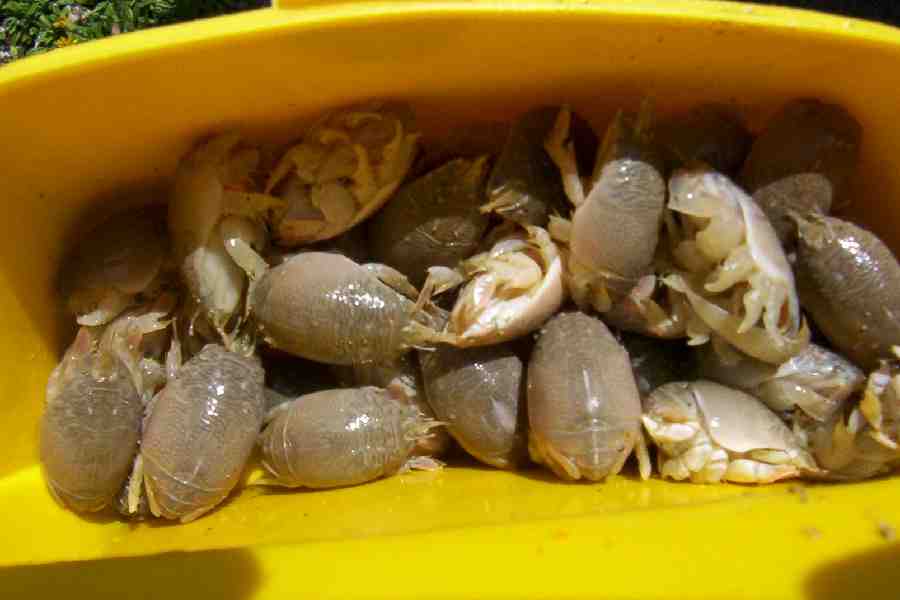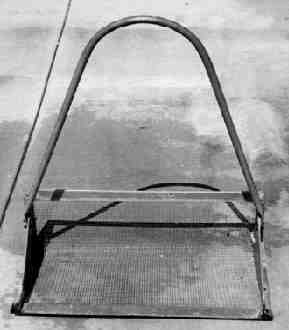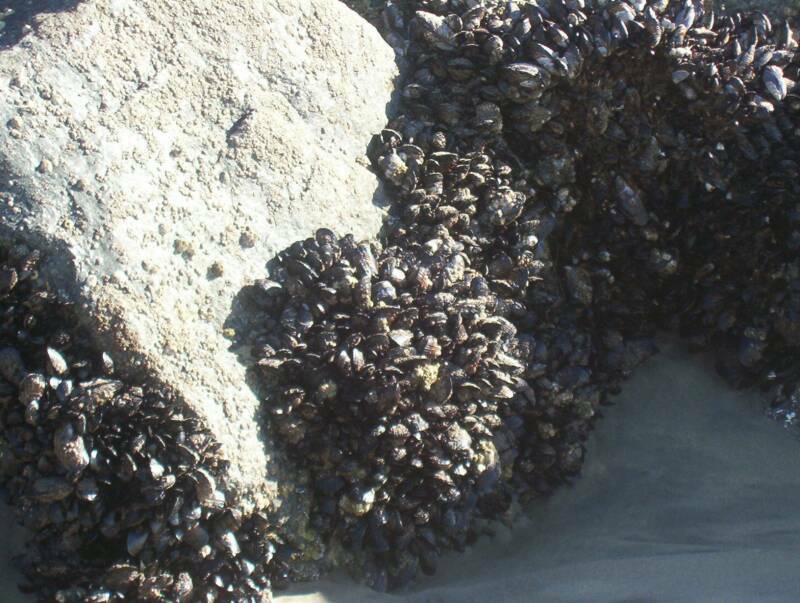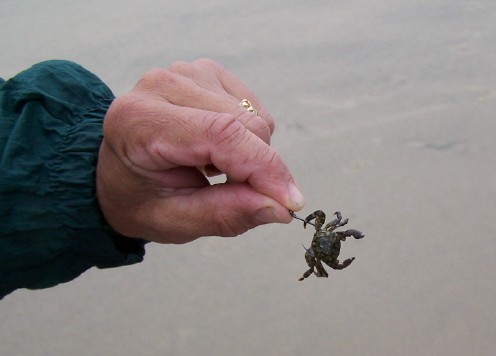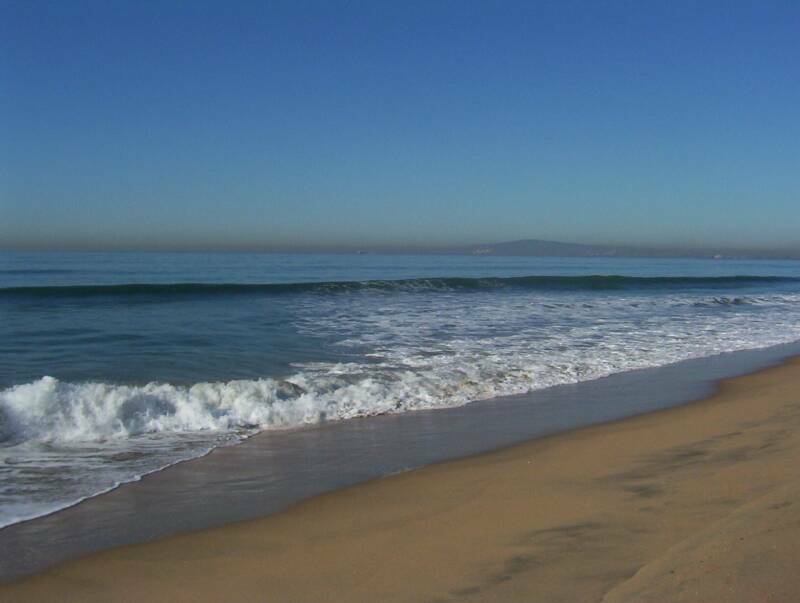By, Bill Varney Jr.
When baseball’s in season and school’s out you can bet it’s summertime. With each summer comes a new harvest of bait for the surf fisherman. Natural baits seem to work best in the summer when fish are finding worms, clams, shrimp and crabs as they emerge from their winter hibernation. Sand crabs top the list as one of the favorite baits for surf fish. Because crabs can’t be purchased in your local tackle shop you’ll have to go to the beach yourself and do a bit of work to catch them.
Once you’re at the beach find a high spot where you can get a good look at the wet sand. Look both ways keeping a keen eye open for birds working the water’s edge. This will be your first clue as to where the crabs lie. When approaching these areas watch closely as the water rushes up and back across the beach. Try to find the V shapes made by the sand crab’s feeding antennae. In some areas these will appear on top of the sand as the water rushes over them. Here you will find sand crabs, just below the surface of the sand, feeding.
There are two ways to catch sand crabs: With your hands and with a crab rake. The best time to catch crabs is one hour before to one hour after high tide.
Digging by hand is a time-tested and back-breaking method for collecting crabs. In mid summer months the crabs will be near the surface. During the winter be prepared to dig deeper to find the crabs. A small hand shovel works well for digging in the soft sand. Collect crabs in a small bucket and rinse the sand from them before use.
Another method for catching crabs is by using a crab rake
(top Promar Rake Bottom Crab n’ Go)
This tool allows you to sift through a large area of sand to find crabs. Because the rake is made from galvanized steel it’s strong and quite durable even in salt water. You’ll find crab rakes like the Crab n’ Go for aboout $25 and large Promar/Ahi Rakes in the $90.00 -$110.00 price range at your local tackle store.
Crab rakes are easy to use but require some strength and balance. With a little practice it should come easy. When using the rake face out to sea. While holding the tool above the sand wait for a wave to rush up the beach. As the wave begins to draw back, drop the net onto the sand and let the water rush through it. Run your foot back and forth to dig up the sand and break the crabs loose. Once the water stops pull the net up and examine its contents.
You’re looking for crabs whose shell is about the consistency of a pop can. That’s right, push on a pop can’s side with your finger, that’s about what the shell should feel like. Shells that are too hard won’t get bites those that are too soft will be mush on the hook—so look for the medium shells and you can’t go wrong.
Sand crabs can be kept for a couple of days at home. Put them in a dry (no water or sand) plastic container with a small piece of kelp or newspaper over them.
Don’t refrigerate or disturb them or they’ll be dead in the morning. If you have crabs leftover and won’t be using them right away, freeze the hardest crabs and save them for a later date.
One of my favorite tricks is to squeeze a pack of taco sauce onto frozen crabs. Once they thaw they work great during winter for bait. Another trick is to freeze crabs with a couple of mussels. When they thaw they will be slightly orange and smell like an extra large fresh mussel. This is guaranteed to drive fish crazy!
Just like sand crabs, mussel makes a great surf bait. There’s no question that at times fresh mussel works better to catch fish than any other bait. Some of the largest perch and corbina I’ve seen have been caught on mussel.
Mussels are found on our local shores anywhere you have substantial tidal movement adjacent to rock, piling or jetty structure. More than anywhere else, mussels seen to thrive on pier and platform pilings. But some of the biggest and oldest mussels can be found on our local jetties.
The best time to collect mussels is at low tide. Take only as many as you’ll need. They are not edible but you may want to collect a few extras to freeze for using later. Let them sit in a dry bucket overnight. The next day the will be slightly open and easier to shuck.
When shucking mussel use a small knife to cut the tendons near the rear of the shell. On one side, near the back, there is a small indentation or hole. Insert your knife into this hole and slowly pull the knife forward cutting the tendon as you go. Once the shell is partly open you can pry it apart with your fingers.
One very soft and pliable another very rubbery and strong. The bright orange inside is soft and pliable. The lip that runs along the edge of the shell is black, brown and orange and is strong and rubbery. Both make good bait.
When hooking mussel I use two methods. One is to wrap the mussel around the hook and use the rubber lip membrane to hold in into place. You can do this by hooking the rubbery lip several times which will hold the mussel into place. The other method is to use only the rubbery lip and hook it like you would a worm. To do this you’ll need to run the hook down through the center of the lip and pull it up your hook. Leave a two inch piece below the hook and your ready to fish.
Mussel is very hardy and will last in a cool moist plastic tray for several days. They can be cleaned immediately or are a bit easier to shuck after being stored for a day or two. I clean extra mussel and place three or four in a small zip bag for later use. Try cutting some squid into small four inch strips and freeze it with the mussel. When it’s thawed it will be orange and smell just like a mussel. Not only does it stay on the hook but you’ll be amazed at how many fish go crazy over it!
While you’re looking for mussel on the rocks you may notice a small army of crabs that dart across the rocks and disappear from sight.These are sidewinder crabs and also make a great surf fishing bait.
While fish wait for mussel to be ripped from the rocks and fall into their food chain they also wait for sidewinders to loose their balance and become their next meal.
The best place to find sidewinders is just above the waterline on rock jetties and tide pool areas. Look for them between mussel clusters, in crevices or by flipping over small rocks. These crabs can be found at both high and low tide and are green and brown in color. Due to their keen sight, once they detect motion they will scurry off.
Catching sidewinders can be quite a challenge. Their speed and agility is amazing but with a bit of practice you’ll be surprised at how quickly you’ll be able to collect a few for fishing.
From a distance stop, look and see where they are positioned on the rocks. Pick out a single crab and as you approach, watch carefully as to where that crab ends up. Now that you’ve located the crab the best way to catch it is to pin it to the rock with your fingers. Pick the crab up with your forefinger and thumb from the back (the opposite side from the claws!) and quickly place him in your waist bait bucket.
Crabs, about the size of a quarter or smaller make the best baits. When hooking the crab, as with most baits, match your hook size to the bait’s size. Once again, grab the crab by the back and insert the sharp end of your hook into their very last leg socket. Pull your hook through the crab and exit the hook through the opposite leg socket. Remember, it’s always important to use sharp hooks and make sure the business end of the hook is protruding through the shell exposed to the barb.
As with mussels, sidewinders kept in a cool plastic container under wet paper or burlap will live for a solid week. Just enough time to slow their pinchers down so you can get “them” on the hook without them getting you.
Mussels, sand crabs and sidewinder crabs are but a few of the great baits available for summer. As ocean temps rise and surf fish flood the shore in search of food there’s no better time then now to get on down to the beach. Once there, remember to look for what occurs naturally. You can be well assured that’s what the fish are eating. Take advantage of the great live baits available on our beaches and always remember to catch and release whenever possible.
Wylies Bait & Tackle. 18757 W Pacific Coast Hwy. Malibu, CA 90264 (310) 456-2321
Norms Big Fish, 1780 Pacific Coast Hwy, Seal Beach, CA 90740-6209 Phone: 562-596-0040
Hogans Bait & Tackle 34320 Pacific Coast Highway, Suite G Dana Point , CA 92629 949-493-3528
Pacific Coast Bait & Tackle 2110 South Coast Hwy, Suite E Oceanside, CA 92054 Phone: 760-439-3474
